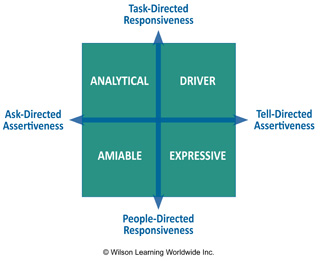Social Styles Versatile Communication
Avoiding the Hidden Costs of Communication Misalignment

"The more I learn about myself, the more I am able to understand others, the more I am able to bridge the gap between us."
How has your organization responded to falling consumer demand and slower sales in the current economic climate? If yours is like most, you've probably experienced a variety of cost cutting measures: layoffs, downsizing, restructuring and reorganization, and hiring and pay freezes. While these kinds of changes have been necessary for survival, they can wreak havoc on overall performance in unexpected ways. Why? Because there is an inevitable increase in stress, anxiety, and relationship tensions experienced by employees who must rapidly adapt to changes in reporting relationships, work assignments, and ongoing concerns about job security. Managers suffer from similar stresses as they are asked to fill in gaps left by layoffs, do "more with less" as budgets are slashed, and take on new work teams or individual employees as a result of restructuring and downsizing. These tensions have a direct impact on organizational performance.
Although organizational leaders can do little to control the external economic factors driving the need for these internal changes, something can be done to alleviate at least one of the biggest causes of day-to-day stress in an uncertain and changing work environment—the relationship tensions that result from adapting to restructured work teams and unfamiliar colleagues and managers. This relationship tension, unless addressed, will breed conflicts, misunderstandings, and overall failures to communicate that weaken performance just when the company needs the highest levels of performance to attain the results required to thrive in a down market. Yet, there is a powerful tool available that can reduce these barriers to productivity and therefore profitability—Versatility.
VERSATILITY—THE ANSWER TO PERFORMANCE SAPPING RELATIONSHIP TENSION AND STRESS
Versatility is defined as the ability to understand differences in communication preferences and to adapt to make others more open and receptive—creating more effective and productive relationships. Versatility is a skill that can be learned, and people who have it find it far easier to work together with others toward shared organizational goals.
To understand Versatility and how it can affect relationships, consider people with whom you have regular contact. Do you know someone who is "too reserved" for your taste? Is there a manager, coworker or family member who seems to you to be "too opinionated," "too emotional," or "too willing (or unwilling) to compromise?" Chances are your reactions to these people are an indicator of differences in Social Style—how we habitually communicate and interact with others. When you find it easy to communicate and work with someone, there's a high probability you share the same social style. When your communication is difficult, it is often because of unrecognized social style differences.
SOCIAL STYLES AND THE 75% PROBLEM

Wilson Learning's social style model defines four primary communication styles—Driver, Expressive, Amiable, and Analytical.
As the model shows, the four styles vary in terms of behaviors reflecting the dimensions of Assertiveness (Tell) versus Responsiveness (Ask) and Task versus People orientation. Drivers and Expressives tend to be more Tell oriented, while Amiables and Analyticals are more Ask oriented. Analyticals and Drivers are more Task oriented, while Amiables and Expressives are more People oriented. Because about 25% of people fall into each of these four categories, you likely share a social style with only about 25% of the people you meet. What are the consequences when we can't adapt to the other 75%?
Consider the communication challenges faced by a non-versatile manager who has a different social style than three-fourths of her employees. An Amiable employee will not be comfortable with a Driver manager who seems too focused on tasks and unconcerned with personal relationships. Analytical employees don't like to be told things they already know—but at the same time they don't want gaps in information a manager could have provided. These kinds of misalignments create the potential for friction, misunderstanding, and lowered productivity.
INCREASING VERSATILITY
For most of us, interpersonal behaviors and preferences are habitual and largely out of awareness. Consider this scenario: A Driver, who has a more "tell" oriented style, may want to "cut to the chase" quickly. He may not even realize the source of his impatience with an Analytical who needs to ask more questions and gather more data before taking action. As the situation progresses, the Driver may push harder for action while the Analytical employee goes into "back up" for her style—withdrawing and becoming less and less responsive. The resultant mutual frustration and distrust means that projects take longer and critical information is lost. Or in another example, an Expressive employee may be put off by a manager with a strong task-oriented style who doesn't show sufficient appreciation of the employee's wish to explore and discuss a variety of creative options before making a decision. The result—a less creative approach to a critical solution.
Versatility comes with the recognition that people do have different styles and that each has unique strengths. Once people know their own style and understand style differences, they can learn how to modify behaviors to make it easier to exchange information and work together to make decisions in a way that is more effective for the whole team. Suppose a manager has several Amiable employees. The manager can make an effort to show a personal interest in them and offer more guidance, support, and recognition than they might provide to experienced Driver employees, who want the freedom to solve problems themselves. When making decisions, managers can adapt to different expectations and needs based on their recognition of employees' styles. Expressives want managers to involve them in a decision when it affects the whole group, and Amiables like to have the group involved in brainstorming and problem solving. On the other hand, Analyticals are not as interested in group decision making and typically prefer to be involved only when decisions or actions affect them directly.
Over time, as both managers and employees develop higher levels of Versatility, they can quickly recognize the indicators of different styles and adapting to them becomes an integral part of how they communicate. Our research shows that a highly versatile individual is perceived as an effective communicator—someone who has "good people skills," a trusted leader, and is a very successful negotiator, salesperson, and manager.
VERSATILITY: KEY TO IMPROVED BUSINESS RESULTS
Companies can experience dramatic, measurable improvements in performance when their people learn how to adapt to others' social styles. In one study, building versatility skills yielded a 52% improvement in the ability to identify styles and recognize back-up behavior—the "fall back" behavior of each style when the individual is stressed. In the same organization, 46% of employees reported a moderate to large improvement in work productivity. As one manager reported, "I've been more sensitive to my driver/driver style and the style of others during [coaching] sessions, and as a result, I believe the sessions have been more productive and conversation/feedback has been freer flowing."
Depending on your company's industry, product offering, and market, increased versatility may make different kinds of contributions to the improvement of business results. What are the critical issues that are most important in your organization right now? For companies that have downsized and reorganized, a versatile leadership team can more quickly adapt to the needs of employees who have moved into new roles. Additionally, versatile employees can shorten the time it takes to become productive in reconfigured work teams, whether they are working together virtually or at the same site.
Organizations challenged by price cutting competition can better keep customers and expand their business by building stronger relationships with current customers and developing a wider range of new business partnerships. Companies seeking to increase the satisfaction and loyalty of current customers will find that versatile customer service employees are more effective communicators and problem solvers in their customer interactions. While there are multiple ways to improve communication in a given situation, the single most important factor for enhancing communication effectiveness across the board is Versatility. As more leaders are required to take on greater responsibilities for more employees in today's business environment, and companies are fighting to retain customers and grow market share in the face of ever tougher competition, building this kind of capability provides a real competitive advantage for the individual and the company as a whole.
To learn more, contact Wilson Learning at 1.800.328.7937 or complete the online form.







 Please complete this form to download Social Styles Versatile Communication | Avoiding the Hidden Costs of Communication Misalignment.
Please complete this form to download Social Styles Versatile Communication | Avoiding the Hidden Costs of Communication Misalignment.



